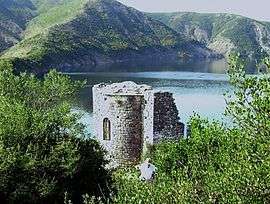Shurdhah Island
|
Medieval church ruins | |
| Geography | |
|---|---|
| Coordinates | 42°04′12″N 19°39′11″E / 42.07000°N 19.65306°E |
| Area | 0.075 km2 (0.029 sq mi) |
| Highest elevation | 290 m (950 ft) |
| Administration | |
|
Albania | |
Shurdhah Island (Albanian: Ishulli i Shurdhahit) is an island in northern Albania. Shurdhah Island is located in the Vau i Dejës Reservoir, which is fed and drained by the river Drin. It is the largest island in the reservoir with an area of 7.5 hectares. From the most northern tip of the island to the most southern tip of it, it has an estimated length of 390 m (1,280 ft). It is mainly covered by trees. It is accessible by tourist boat in summer from the Vau i Dejës dam or Rragam.
Etymology
The name of the original Illyrian settlement was Sarda. Later, the name was changed to Shurdha which means deaf in Albanian. The name changed while Albania was an Atheist Communist state because due to the strong religious connection of the island, it was forgotten.
History
Middle Ages
Sarda was founded between the 6th and 8th centuries BC. The town was strategically located on the old road from Shkodër to Gjakova and served as a resting point along the trade route.[1] The city largely flourished from the 8th to the 13th centuries and was an important cultural and religious center. Within the city there were 365 altars, each devoted to a different saint. It gained its highest importance in the 12th century, when it was the seat of the bishop of Sapa and Sarda. Foundations of a Roman fort have been discovered here along with the earliest remains dating from the 6th-8th century AD. The island was the original settlement of the feudal Lekë Dukagjini patriarch, famous for the rules of the Kanun.[2] It was ravaged by the Ottomans in 1491.[3]
20th century
In 1973, when the dam was completed, the city of Sarda became an island on the left bank of the river Drin.
Tourism
Now it is possible to visit the ruins of the 11th-century medieval castle, which includes two rings of defensive walls and towers (some sadly submerged in the lake), the remains of a Byzantine church and other early medieval walls. The setting on the steep rocks rising from the lake is especially impressive.
References
- ↑ Tourist brochure on the Shkodër County website
- ↑ Jubica, Irhan. "Shkodra, vendi i gjenezës" (in Albanian). Albanian Travel Magazine. Retrieved March 12, 2012.
- ↑ Elsie, Robert (2010). Historical dictionary of Albania. Plymouth: Scarecrow Press. p. 396. ISBN 978-0-8108-6188-6.
Coordinates: 42°04′12″N 19°39′11″E / 42.07000°N 19.65306°E
